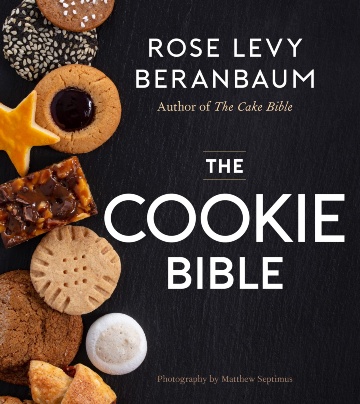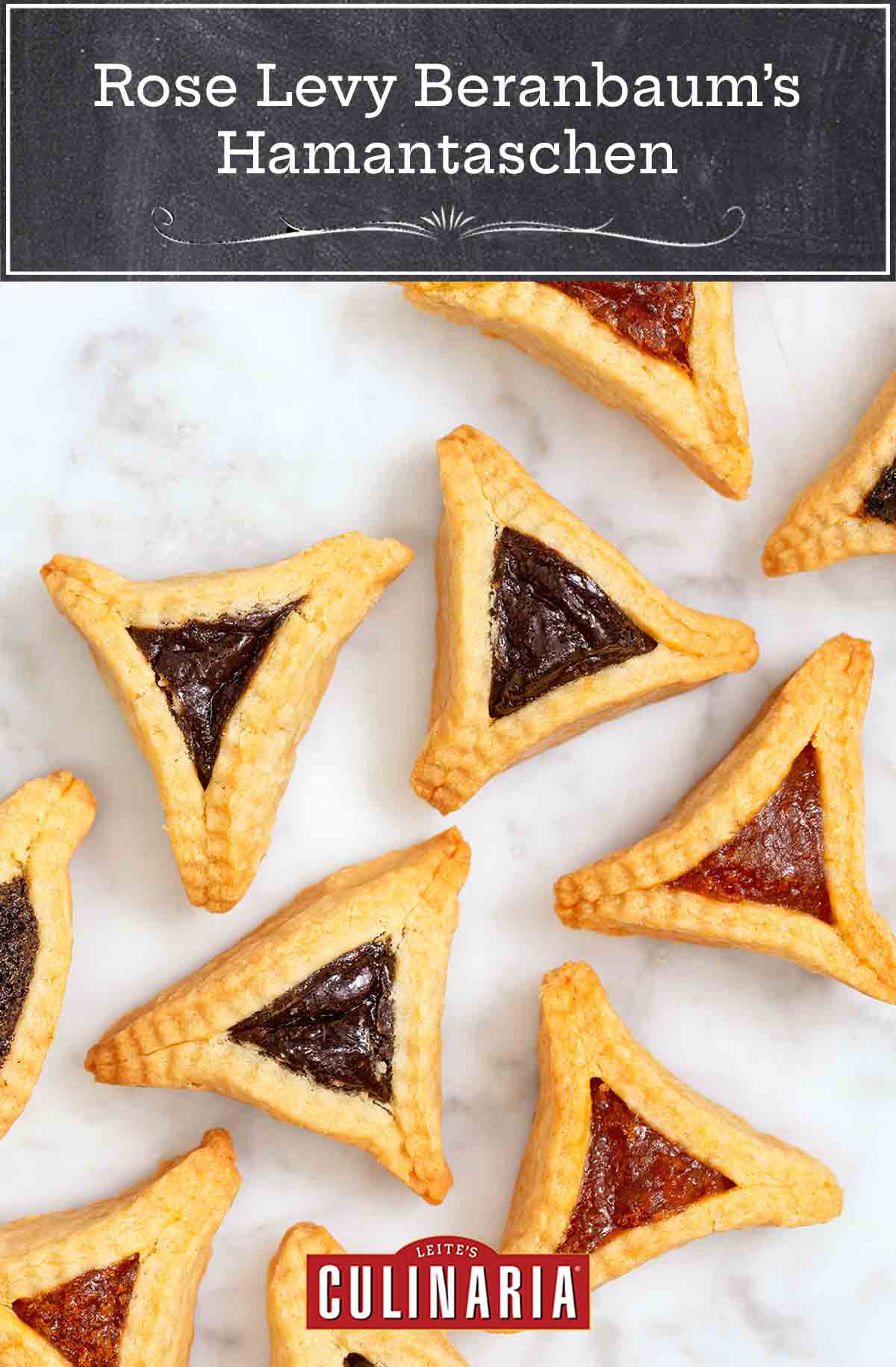
Hamantaschen are the cookies traditionally made for the Jewish holiday Purim.
They’re easy to shape but not as easy to bake because if the dough is tender–as it should be–the lovely triangle shape tends to collapse. Bakers often compensate by making a sturdier dough, which is then less delicious.
I’m delighted to offer this simple solution: Make reusable aluminum foil “pans” to provide support for picture-perfect little pastries.
Apricot and prune fillings are also delicious, but I always reach for the poppy-seed hamantaschen. I love the slightly crunchy poppy seed filling with the crisp, tender, buttery dough. I find a smaller cookie most appealing and easiest to eat, and no one is going to stop you from eating two or even three!–Rose Levy Beranbaum

Why Our Testers Loved This
Linda P. was delighted that “the cookies turned out exactly as I imagined, with a tender, flaky dough, and a perfectly complementary filling.”
Nadine B. agreed with Linda that the dough was “light, flaky, and delicious,” and she loved that they “looked like little jewels.”
Notes on Ingredients
- Poppy seeds–Poppy seeds have a high oil content and are therefore prone to going rancid, especially if purchased ground rather than whole. When poppy seeds start to turn, they taste very bitter. To avoid that, store whole or ground poppy seeds in an airtight container in the freezer. If you’re purchasing ground poppy seeds and don’t have a scale, measure out 3/4 cup.
- Honey–Use mild-flavored honey here, as strong ones, such as buckwheat or chestnut, will overpower the flavor of the filling.
- Apricot preserves–To prepare the apricot filling, place about 1/4 cup of apricot preserves in a microwavable container and bring it to a boil. (Alternatively, place the preserves in a small saucepan and bring to a boil over medium-low heat, stirring constantly.) Using the back of a spoon, push the preserves through a strainer into a small bowl; discard the small amount of pulp.
Step-by-Step Instructions
- Prepare the butter, cream and flour mixtures. Cube and chill the butter. Whisk the cream and egg yolk. Whisk the flour and salt.
- Make the dough in a food processor. Blitz the sugar. Add the butter mixture then flour, pulsing between each addition. Add the egg mixture and pulse until just combined.
- Bring the dough together and knead until smooth. Divide the dough in half and wrap it in plastic. Chill until firm.
- Make the filling. Grind the poppy seeds and stir them into the milk. Stir in the sugar, honey, lemon zest, and a bit of preserves.
- Prepare the egg glaze. Mix the egg and milk together, then strain into a small bowl.
- Roll the dough between two pieces of plastic wrap. Cut out round cookies.
- Dollop the filling on the center of each cookie.
- Shape the cookies into triangles. Press foil circles around the outside of each to help them keep their shape. Chill.
- Bake the hamantaschen until golden brown.
Want to Save This?
Recipe FAQs
As author Rose Levy Beranbaum explains, “Hamantaschen are the cookies traditionally made for the Jewish holiday Purim. They’re triangle shaped to represent the hat worn by the villain Haman in the Purim story.”
They were originally made with a yeast-based dough, but over time, with the availability of baking powder, have become more of a cookie. Poppy seed filling is the most common, however, fillings made with dates, as well as apricot jam or raspberry jam are popular. You may even find them with chocolate, Nutella, or even savory fillings.
Baked and cooled hamantaschen can be frozen in an airtight container for up to 3 months. Defrost completely before serving.
Yes. Assembled, unbaked hamantaschen can be prepared a day in advance and stored in the fridge until you’re ready to bake them. The hamantaschen dough can be prepared up to 3 days before baking, or frozen for up to 6 months. Thaw in the refrigerator overnight before rolling.
Pro Tips & Troubleshooting
- The best way to grind poppy seeds is in a specially designed poppy-seed grinder. A blender will work, but not quite as well, and forget about a food processor.
- The egg glaze can be replaced with water.
- Like all delicate pastries, these are best served the day they’re made. But they’ll keep, lightly covered, at room temperature for up to 5 days, or frozen for longer storage.
More Popular Jewish Holiday Desserts


Write a Review
If you make this recipe, or any dish on LC, consider leaving a review, a star rating, and your best photo in the comments below. I love hearing from you.–David

Hamantaschen
Equipment
- 1 (3-inch | 8-cm) round or scalloped cookie cutter
- 24 (4-inch | 10-cm) disks cut from aluminum foil
Ingredients
For the sweet cookie dough
- 1 stick (4 oz) unsalted butter, cold
- 1 to 2 large egg yolks
- 3 tablespoons heavy cream
- 1 2/3 cups all-purpose flour, preferably unbleached, lightly spooned into the cup and leveled off
- 1/8 teaspoon fine sea salt
- 1/4 cup turbinado sugar, or granulated sugar
For the poppy seed filling
- 2/3 cup plus 2 tablespoons poppy seeds
- 1/3 cup whole milk
- 1/4 cup granulated sugar
- 1 tablespoon plus 1 teaspoon honey
- 2 teaspoons lemon zest, finely grated
- 2 tablespoons strained apricot preserves, divided
- Apricot brandy or water (optional)
For the egg glaze
- 1 to 2 large egg yolks
- 1 teaspoon whole milk
Instructions
Make the sweet cookie dough
- Cut the butter into cubes and refrigerate for at least 30 minutes. In a liquid measuring cup, whisk the cream and egg yolk together. Cover and refrigerate.
- In a medium bowl, whisk together the flour and salt.
- In a food processor, blitz the sugar until fine. Toss in the cold butter cubes and pulse until the sugar disappears. Add the flour mixture and pulse until the butter pieces are no larger than small peas.
- Add the egg mixture and pulse just until incorporated, about 8 times. The dough will be in crumbly pieces.
- Empty the dough into a plastic bag and use the outside of the bag to press it just until it holds together. Remove the dough from the plastic bag and place it on a very large sheet of plastic wrap. Using the plastic wrap, knead the dough just a few times, until it becomes one smooth piece, and there are no visible pieces of butter.
- Divide the dough in half. Wrap each piece loosely in plastic wrap and press to flatten it into a 4 inch (10 cm) disk. Refrigerate for at least 30 minutes, or until firm enough to roll.
Make the poppy seed filling
- In a spice mill or blender, grind the poppy seeds. If using ground poppy seeds, measure 3/4 cup.
- In a small saucepan, heat the milk over low heat until hot. Add the poppy seeds and stir until the milk is absorbed.
- Remove the saucepan from the heat and stir in the sugar, honey, lemon zest, and 1 tablespoon of the apricot preserves until incorporated. Cool the filling to room temperature. Reserve and cover the remaining 1 tablespoon apricot preserves.
Make the glaze
- In a small bowl, whisk together the egg yolk and milk. Strain the mixture into another small bowl, pushing it through with the back of a spoon. (If it doesn't flow smoothly, let it sit at room temperature for a few minutes.)
Roll the dough
- Remove a disk of dough from the refrigerator. If the dough has been chilled for more than 30 minutes, allow it to sit until it is soft enough to roll, 5 to 10 minutes.
- Lightly dust a large piece of plastic wrap with flour. Set the dough on top and lightly flour the top. Cover with another piece of plastic wrap and roll the dough into a 1/8-inch (3-mm) thick oval.
- Remove the top piece of plastic wrap and cut out the cookies with the 3-inch (8-cm) cutter. Place each one on a foil disc. Gather up the scraps and knead them together lightly. Shape into a flat patty, wrap in plastic wrap, and refrigerate until firm enough to reroll.
- Repeat with the remaining disk of dough.
Assemble the hamantaschen
- Brush the outer 1/2 inch (6 mm) of each dough round with a thin coating of egg glaze. Place 2 teaspoons poppy seed filling mounded in the center of the round.
- Firmly pinch the dough together at three equally spaced places to form the three-corner-hat effect. Press the foil up against the sides of the dough to conform to the shape, then fold in the excess foil at each corner to secure it. Bend back the top edges of the foil slightly so they don’t rise above the dough.
- Line a rimmed baking sheet with parchment paper. Place the hamantaschen about 1 1/2 inches (4 cm) apart on the baking sheet. Refrigerate, covered with plastic wrap, until firm, at least 30 minutes or up to overnight.
Bake the hamantaschen
- Preheat the oven to 350°F (180°C) with a rack set in the middle position.
- Bake until the hamantaschen are lightly browned, rotating the baking sheet once during cooking, 15 to 20 minutes. Set the baking sheet on a wire rack. Use the edges of the foil “pans” to lift the hamantaschen to a separate wire rack to cool completely.
- When the cookies are cool, brush the poppy seed filling with the remaining 1 tablespoon of apricot preserves. If necessary, stir in a little apricot brandy or hot water to make it more liquid. Remove the hamantaschen from the foil before serving.
Notes
- Grinding poppy seeds–The best way to grind poppy seeds is in a specially designed poppy-seed grinder. A blender will work, but not quite as well. Forget about a food processor.
- Substitutions–The egg glaze can be replaced with water.
- Storage–These are best served the day they are made, but will keep, lightly covered, at room temperature for up to 5 days, or can be frozen in an airtight container for up to 6 months.
- Make ahead–The sweet cookie dough can be prepared up to 3 days before baking. The unbaked hamantaschen can be assembled up to 1 day before baking.

Explore More with AI
Nutrition
Nutrition information is automatically calculated, so should only be used as an approximation.
Recipe Testers’ Reviews
Truth be told, I have made hundreds of cookie recipes in my lifetime, but I was not at all familiar with hamantaschen. In other words, I took a leap of faith making a recipe of one of the few ethnic groups whose food I rarely make or for that matter know very much about.

This hamantaschen recipe did not at all disappoint. The cookies turned out exactly as I imagined them with a tender, flaky dough and a perfectly complementary filling.
I am away in our condo in Florida for several weeks, so my kitchen and pantry here do not have all the “bells and whistles” of my New Jersey kitchen. For that reason, I chose not to make a filling and went with store-bought apricot preserves which worked out very well.
The use of aluminum foil pans is absolute genius. Not only does the foil maintain the shape of the triangles during the baking process, but it also makes it super-easy to transfer the cookies from the baking sheet to the cooling rack.
I used a slightly larger cutter (actually it was the top of a coffee cup), so my yield was only 18 cookies, but I’m pretty sure you can get 24 if you use a proper 3-inch cookie cutter.
These hamantaschen cookies look and taste like little jewels. The dough is light, flakey, and buttery.
I chose to use apricot preserves as the filling, and it nicely complemented the dough. The cookies are not too sweet, so they’re nice as dessert and wonderful with morning coffee the next day. A batch of two dozen was gone very quickly.
I found the cookies were best on the first day, but still quite good by day three. Because the recipe calls for refrigerating the ready-to-bake cookies for 30 minutes to overnight, these can be made and assembled the day before you bake and serve them.













“Hamantashen” (Yiddish for “Haman’s pockets”) most likely started off as “mohn taschen” (German for “poppy seed pockets”). The obvious wordplay made it easy for Eastern European Jews to associate this sweet treat with Haman, the villain in the springtime holiday of Purim. For many years, poppy seed and lekvar (prune), Eastern European jams, were pretty much the standard fillings. It is only relatively recently that raspberry and apricot fillings became popular in the United States, supplanting the others.
These days, an infinite variety of fillings are used, including nutella (which might be a bit runny), speculoos butter, and even, most recently, savory hamantashen (a real revolution). Use your favorite filling, but choose a thick one.
I just saw a video talk with Israeli baker Vered Guttman, who reminded us that the Hebrew term for these cookies is “oznei haman” – “Haman’s ears”. She said that there are other cookies in other Jewish traditions that are made of “varous parts of Haman’s body” (Eek!). She demonstrated how to make “Haman’s fingers”, a Middle Eastern Jewish cookie made of a nut paste rolled up, like a cigar, in phyllo. The recipe is on the web, and looks surprisingly easy to make.
Thank you for all the great, and fun information, Steve!